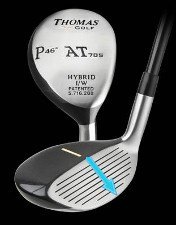
In golf, “club loft” refers to the angle between the clubface and the vertical plane. It is a measurement of how much the face of the club is tilted back relative to the ground. Club loft plays a significant role in determining the trajectory, distance, and shot shape of a golf ball when struck.
Here are a few key points about club loft:
- Loft and Launch Angle: The loft of a club directly affects the launch angle of the ball. A higher lofted club, such as a pitching wedge or a lob wedge, will launch the ball at a higher angle, resulting in a higher trajectory and shorter distance. Conversely, a lower lofted club, such as a driver or a 3-wood, will launch the ball at a lower angle, leading to a lower trajectory and potentially longer distance.
- Distance and Carry: Loft also influences the distance the ball carries. Clubs with higher loft generate more backspin, which helps keep the ball in the air longer and contributes to increased carry distance. Lower lofted clubs produce less backspin, allowing the ball to roll out more upon landing and potentially achieve longer total distance.
- Shot Shape: Club loft can influence the shot shape or curvature of the ball's flight. Higher lofted clubs tend to promote a more upward and arcing ball flight, which can result in shots with more backspin and a steeper descent angle. Lower lofted clubs, on the other hand, typically produce a flatter trajectory and shots that have less spin and a shallower descent angle.
- Club Selection: Golfers choose clubs with different lofts depending on the distance they want to achieve and the shot they need to play. For example, wedges with higher lofts are used for shorter shots, approach shots into the green, and shots that require a high trajectory to carry over obstacles. Drivers and fairway woods with lower lofts are typically used for tee shots and longer shots where distance is a priority.
- Club Set Makeup: The loft progression in a set of irons typically follows a pattern, with lower lofted clubs at the long end (e.g., 3-iron) and higher lofted clubs at the short end (e.g., pitching wedge). This loft progression allows golfers to have a variety of distance options and shot types throughout their round.
Understanding club loft and its impact on ball flight helps golfers make informed club selections and shot decisions. It is important to note that loft is just one factor among many that influence golf shots, and other factors such as swing mechanics, clubhead speed, angle of attack, and golf ball characteristics also play significant roles. Custom fitting and consultation with a golf professional can provide further guidance on optimizing club loft and club selection for an individual golfer's game.
Also called face angle, loft is the angle (in degrees) from the center of the clubface relative to the shaft position. Higher-numbered clubs (i.e. 9-iron) have more loft than clubs with lower numbers (4-iron). Generally speaking, the more loft a club has, the higher and shorter the ball will travel.
Every club, including the putter, has a lofted face.





